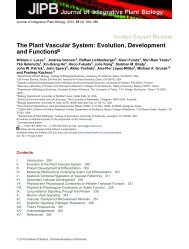Roles of SNARE Proteins in Synaptic Vesicle Fusion - Department of ...
Roles of SNARE Proteins in Synaptic Vesicle Fusion - Department of ...
Roles of SNARE Proteins in Synaptic Vesicle Fusion - Department of ...
You also want an ePaper? Increase the reach of your titles
YUMPU automatically turns print PDFs into web optimized ePapers that Google loves.
40 M.T. Palfreyman, E.M. Jorgensen<br />
Fig. 3.2 Acceptor complex and zipper model for <strong>SNARE</strong> assembly. The Q <strong>SNARE</strong>s syntax<strong>in</strong> and<br />
SNAP-25 assemble on the plasma membrane. This Qabc acceptor complex then contacts the<br />
distal N-term<strong>in</strong>us <strong>of</strong> synaptobrev<strong>in</strong> on the synaptic vesicle. This conformation is known as a<br />
“loose” <strong>SNARE</strong> complex. The “zipper<strong>in</strong>g” <strong>of</strong> the rest <strong>of</strong> the <strong>SNARE</strong>s <strong>in</strong>to the complex serves two<br />
potential functions. First, full assembly <strong>of</strong> the <strong>SNARE</strong>s leads to close proximity between the<br />
membranes dest<strong>in</strong>ed to fuse. Second, the zipper<strong>in</strong>g might provide torque that is transferred to the<br />
transmembrane doma<strong>in</strong> lead<strong>in</strong>g to full fusion<br />
Synaptobrev<strong>in</strong> is located on synaptic vesicles, while syntax<strong>in</strong> and SNAP-25 are on<br />
the plasma membrane. The assembly <strong>of</strong> synaptobrev<strong>in</strong>, syntax<strong>in</strong>, and SNAP-25 <strong>in</strong>to<br />
the <strong>SNARE</strong> complex would thus bridge the vesicle and plasma membrane, form<strong>in</strong>g<br />
what is known as a trans <strong>SNARE</strong> complex (Fig. 3.1A).<br />
Assembly and Disassembly Cycles <strong>in</strong> <strong>SNARE</strong> Function<br />
The steps <strong>in</strong> the assembly <strong>of</strong> the trans <strong>SNARE</strong> complex are still <strong>in</strong> dispute. Based<br />
on biochemical experiments us<strong>in</strong>g the yeast <strong>SNARE</strong>s, it was proposed that homologues<br />
<strong>of</strong> syntax<strong>in</strong> (Sso1p) and SNAP-25 (Sec9p) might form an “acceptor complex”<br />
(55) (Fig. 3.2). A syntax<strong>in</strong>–SNAP-25 complex was also subsequently proposed<br />
for the neuronal <strong>SNARE</strong>s (56). This acceptor complex greatly speeds up the assembly<br />
<strong>of</strong> the core complex (57). However, it is not known whether this complex exists <strong>in</strong><br />
vivo. It has been shown that SNAP-25 and syntax<strong>in</strong> can stably associate <strong>in</strong> cells (58).<br />
Specifically, a fluorescently tagged SNAP-25 generated an <strong>in</strong>tramolecular fluorescence<br />
resonance energy transfer (FRET) signal upon assembly with syntax<strong>in</strong> <strong>in</strong><br />
PC12 cells.<br />
This acceptor complex compris<strong>in</strong>g one SNAP-25 molecule and one syntax<strong>in</strong> molecule<br />
is highly reactive and will rapidly <strong>in</strong>corporate a second syntax<strong>in</strong> molecule to<br />
form a dead-end Qaabc complex (55–58). This dead-end complex might be prevented<br />
<strong>in</strong> vivo by the action <strong>of</strong> tomosyn, a molecule with an R-<strong>SNARE</strong> doma<strong>in</strong> (59,60). By<br />
occupy<strong>in</strong>g the synaptobrev<strong>in</strong> position <strong>in</strong> the complex, tomosyn might prevent the<br />
accumulation <strong>of</strong> the nonproductive Qaabc complexes and thus promote <strong>SNARE</strong> complex<br />
formation (60,61). However, this model is not consistent with the largely <strong>in</strong>hibitory<br />
role for tomosyn; genetic knockouts yield large <strong>in</strong>creases <strong>in</strong> synaptic vesicle<br />
release (62,63). Tomosyn is thus more likely to b<strong>in</strong>d to the acceptor complexes and,<br />
just like the Qaabc complexes, might form <strong>in</strong>active complexes (62–64).<br />
Wang_Ch03.<strong>in</strong>dd 40 5/15/2008 5:27:12 PM
















